Heng Wang
Dual-Mode Magnetic Continuum Robot for Targeted Drug Delivery
Oct 02, 2025Abstract:Magnetic continuum robots (MCRs) enable minimally invasive navigation through tortuous anatomical channels, yet axially magnetized designs have largely been limited to bending-only motion. To expand deformation capabilities, this paper presents a simple assembly that embeds permanent magnets radially within the catheter wall, allowing a single externally steered permanent magnet to independently induce either bending or torsion. A physics-based formulation together with finite-element analysis establishes the actuation principles, and benchtop experiments validate decoupled mode control under practical fields. Building on this, a dual-layer blockage mechanism consisting of outer grooves and inner plates leverages torsional shear to achieve on-demand drug release. Finally, an in-phantom intervention experiment demonstrates end-to-end operation: lumen following by bending for target approach, followed by twist-activated release at the site. The resulting compact, cable-free platform combines versatile deformation with precise payload delivery, indicating strong potential for next-generation, site-specific therapies.
Continuously Steering LLMs Sensitivity to Contextual Knowledge with Proxy Models
Aug 28, 2025Abstract:In Large Language Models (LLMs) generation, there exist knowledge conflicts and scenarios where parametric knowledge contradicts knowledge provided in the context. Previous works studied tuning, decoding algorithms, or locating and editing context-aware neurons to adapt LLMs to be faithful to new contextual knowledge. However, they are usually inefficient or ineffective for large models, not workable for black-box models, or unable to continuously adjust LLMs' sensitivity to the knowledge provided in the context. To mitigate these problems, we propose CSKS (Continuously Steering Knowledge Sensitivity), a simple framework that can steer LLMs' sensitivity to contextual knowledge continuously at a lightweight cost. Specifically, we tune two small LMs (i.e. proxy models) and use the difference in their output distributions to shift the original distribution of an LLM without modifying the LLM weights. In the evaluation process, we not only design synthetic data and fine-grained metrics to measure models' sensitivity to contextual knowledge but also use a real conflict dataset to validate CSKS's practical efficacy. Extensive experiments demonstrate that our framework achieves continuous and precise control over LLMs' sensitivity to contextual knowledge, enabling both increased sensitivity and reduced sensitivity, thereby allowing LLMs to prioritize either contextual or parametric knowledge as needed flexibly. Our data and code are available at https://github.com/OliveJuiceLin/CSKS.
OpenCUA: Open Foundations for Computer-Use Agents
Aug 12, 2025Abstract:Vision-language models have demonstrated impressive capabilities as computer-use agents (CUAs) capable of automating diverse computer tasks. As their commercial potential grows, critical details of the most capable CUA systems remain closed. As these agents will increasingly mediate digital interactions and execute consequential decisions on our behalf, the research community needs access to open CUA frameworks to study their capabilities, limitations, and risks. To bridge this gap, we propose OpenCUA, a comprehensive open-source framework for scaling CUA data and foundation models. Our framework consists of: (1) an annotation infrastructure that seamlessly captures human computer-use demonstrations; (2) AgentNet, the first large-scale computer-use task dataset spanning 3 operating systems and 200+ applications and websites; (3) a scalable pipeline that transforms demonstrations into state-action pairs with reflective long Chain-of-Thought reasoning that sustain robust performance gains as data scales. Our end-to-end agent models demonstrate strong performance across CUA benchmarks. In particular, OpenCUA-32B achieves an average success rate of 34.8% on OSWorld-Verified, establishing a new state-of-the-art (SOTA) among open-source models and surpassing OpenAI CUA (GPT-4o). Further analysis confirms that our approach generalizes well across domains and benefits significantly from increased test-time computation. We release our annotation tool, datasets, code, and models to build open foundations for further CUA research.
DesignLab: Designing Slides Through Iterative Detection and Correction
Jul 23, 2025Abstract:Designing high-quality presentation slides can be challenging for non-experts due to the complexity involved in navigating various design choices. Numerous automated tools can suggest layouts and color schemes, yet often lack the ability to refine their own output, which is a key aspect in real-world workflows. We propose DesignLab, which separates the design process into two roles, the design reviewer, who identifies design-related issues, and the design contributor who corrects them. This decomposition enables an iterative loop where the reviewer continuously detects issues and the contributor corrects them, allowing a draft to be further polished with each iteration, reaching qualities that were unattainable. We fine-tune large language models for these roles and simulate intermediate drafts by introducing controlled perturbations, enabling the design reviewer learn design errors and the contributor learn how to fix them. Our experiments show that DesignLab outperforms existing design-generation methods, including a commercial tool, by embracing the iterative nature of designing which can result in polished, professional slides.
Step-Audio-AQAA: a Fully End-to-End Expressive Large Audio Language Model
Jun 10, 2025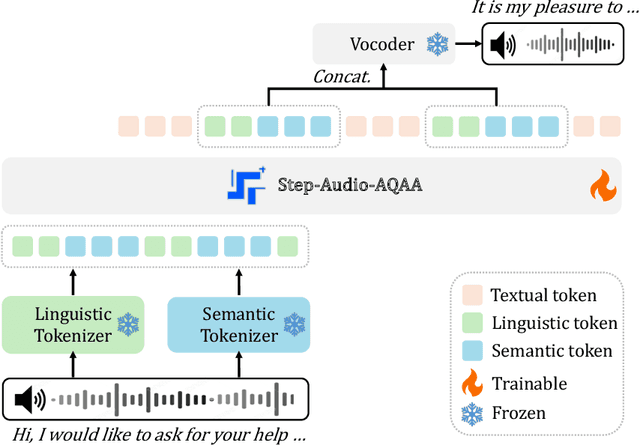
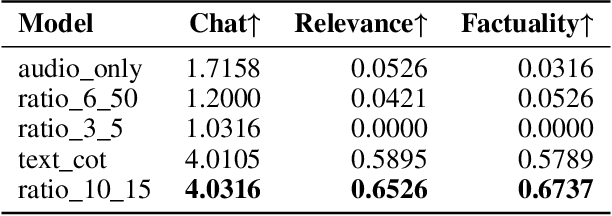
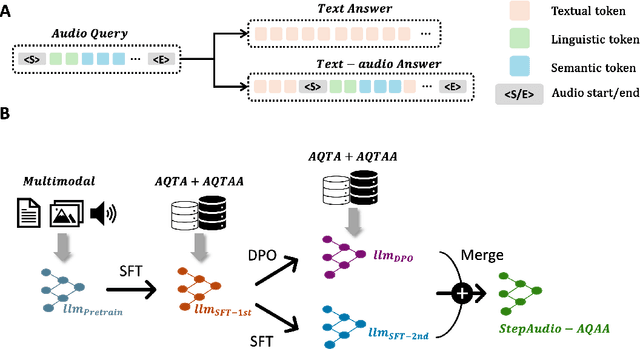

Abstract:Large Audio-Language Models (LALMs) have significantly advanced intelligent human-computer interaction, yet their reliance on text-based outputs limits their ability to generate natural speech responses directly, hindering seamless audio interactions. To address this, we introduce Step-Audio-AQAA, a fully end-to-end LALM designed for Audio Query-Audio Answer (AQAA) tasks. The model integrates a dual-codebook audio tokenizer for linguistic and semantic feature extraction, a 130-billion-parameter backbone LLM and a neural vocoder for high-fidelity speech synthesis. Our post-training approach employs interleaved token-output of text and audio to enhance semantic coherence and combines Direct Preference Optimization (DPO) with model merge to improve performance. Evaluations on the StepEval-Audio-360 benchmark demonstrate that Step-Audio-AQAA excels especially in speech control, outperforming the state-of-art LALMs in key areas. This work contributes a promising solution for end-to-end LALMs and highlights the critical role of token-based vocoder in enhancing overall performance for AQAA tasks.
Unveiling the Hidden: Movie Genre and User Bias in Spoiler Detection
Apr 28, 2025Abstract:Spoilers in movie reviews are important on platforms like IMDb and Rotten Tomatoes, offering benefits and drawbacks. They can guide some viewers' choices but also affect those who prefer no plot details in advance, making effective spoiler detection essential. Existing spoiler detection methods mainly analyze review text, often overlooking the impact of movie genres and user bias, limiting their effectiveness. To address this, we analyze movie review data, finding genre-specific variations in spoiler rates and identifying that certain users are more likely to post spoilers. Based on these findings, we introduce a new spoiler detection framework called GUSD (The code is available at https://github.com/AI-explorer-123/GUSD) (Genre-aware and User-specific Spoiler Detection), which incorporates genre-specific data and user behavior bias. User bias is calculated through dynamic graph modeling of review history. Additionally, the R2GFormer module combines RetGAT (Retentive Graph Attention Network) for graph information and GenreFormer for genre-specific aggregation. The GMoE (Genre-Aware Mixture of Experts) model further assigns reviews to specialized experts based on genre. Extensive testing on benchmark datasets shows that GUSD achieves state-of-the-art results. This approach advances spoiler detection by addressing genre and user-specific patterns, enhancing user experience on movie review platforms.
Kimi-VL Technical Report
Apr 10, 2025

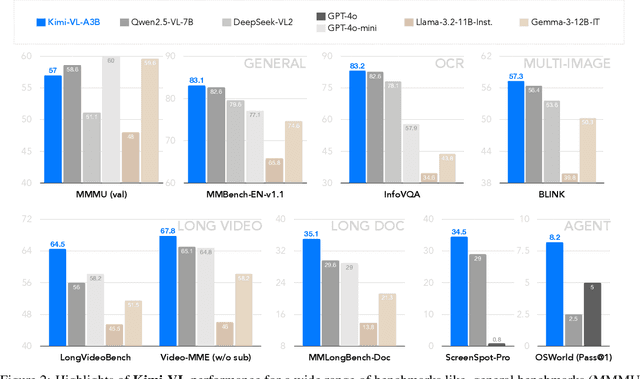

Abstract:We present Kimi-VL, an efficient open-source Mixture-of-Experts (MoE) vision-language model (VLM) that offers advanced multimodal reasoning, long-context understanding, and strong agent capabilities - all while activating only 2.8B parameters in its language decoder (Kimi-VL-A3B). Kimi-VL demonstrates strong performance across challenging domains: as a general-purpose VLM, Kimi-VL excels in multi-turn agent tasks (e.g., OSWorld), matching flagship models. Furthermore, it exhibits remarkable capabilities across diverse challenging vision language tasks, including college-level image and video comprehension, OCR, mathematical reasoning, and multi-image understanding. In comparative evaluations, it effectively competes with cutting-edge efficient VLMs such as GPT-4o-mini, Qwen2.5-VL-7B, and Gemma-3-12B-IT, while surpassing GPT-4o in several key domains. Kimi-VL also advances in processing long contexts and perceiving clearly. With a 128K extended context window, Kimi-VL can process diverse long inputs, achieving impressive scores of 64.5 on LongVideoBench and 35.1 on MMLongBench-Doc. Its native-resolution vision encoder, MoonViT, further allows it to see and understand ultra-high-resolution visual inputs, achieving 83.2 on InfoVQA and 34.5 on ScreenSpot-Pro, while maintaining lower computational cost for common tasks. Building upon Kimi-VL, we introduce an advanced long-thinking variant: Kimi-VL-Thinking. Developed through long chain-of-thought (CoT) supervised fine-tuning (SFT) and reinforcement learning (RL), this model exhibits strong long-horizon reasoning capabilities. It achieves scores of 61.7 on MMMU, 36.8 on MathVision, and 71.3 on MathVista while maintaining the compact 2.8B activated LLM parameters, setting a new standard for efficient multimodal thinking models. Code and models are publicly accessible at https://github.com/MoonshotAI/Kimi-VL.
Open-Qwen2VL: Compute-Efficient Pre-Training of Fully-Open Multimodal LLMs on Academic Resources
Apr 02, 2025Abstract:The reproduction of state-of-the-art multimodal LLM pre-training faces barriers at every stage of the pipeline, including high-quality data filtering, multimodal data mixture strategies, sequence packing techniques, and training frameworks. We introduce Open-Qwen2VL, a fully open-source 2B-parameter Multimodal Large Language Model pre-trained efficiently on 29M image-text pairs using only 220 A100-40G GPU hours. Our approach employs low-to-high dynamic image resolution and multimodal sequence packing to significantly enhance pre-training efficiency. The training dataset was carefully curated using both MLLM-based filtering techniques (e.g., MLM-Filter) and conventional CLIP-based filtering methods, substantially improving data quality and training efficiency. The Open-Qwen2VL pre-training is conducted on academic level 8xA100-40G GPUs at UCSB on 5B packed multimodal tokens, which is 0.36% of 1.4T multimodal pre-training tokens of Qwen2-VL. The final instruction-tuned Open-Qwen2VL outperforms partially-open state-of-the-art MLLM Qwen2-VL-2B on various multimodal benchmarks of MMBench, SEEDBench, MMstar, and MathVista, indicating the remarkable training efficiency of Open-Qwen2VL. We open-source all aspects of our work, including compute-efficient and data-efficient training details, data filtering methods, sequence packing scripts, pre-training data in WebDataset format, FSDP-based training codebase, and both base and instruction-tuned model checkpoints. We redefine "fully open" for multimodal LLMs as the complete release of: 1) the training codebase, 2) detailed data filtering techniques, and 3) all pre-training and supervised fine-tuning data used to develop the model.
ROS-SAM: High-Quality Interactive Segmentation for Remote Sensing Moving Object
Mar 15, 2025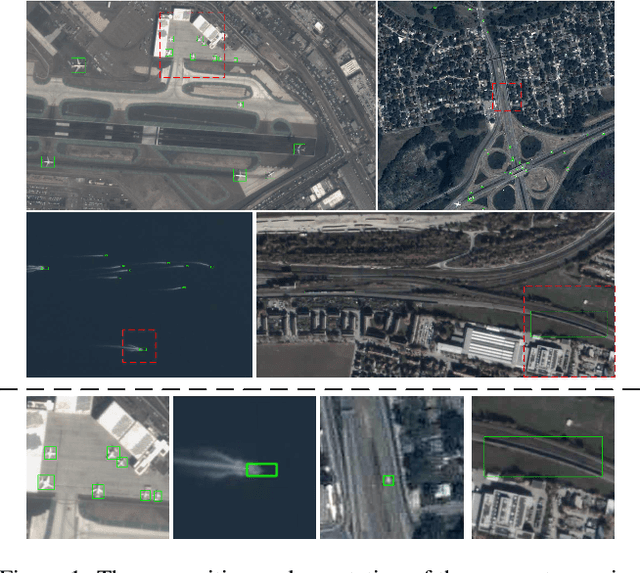
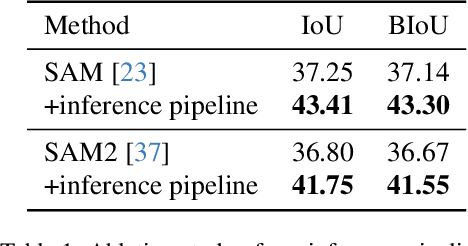
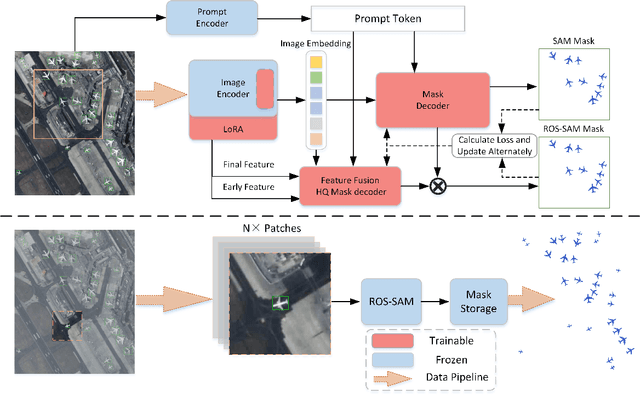
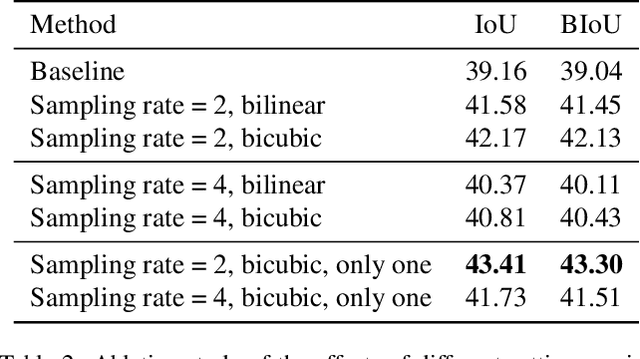
Abstract:The availability of large-scale remote sensing video data underscores the importance of high-quality interactive segmentation. However, challenges such as small object sizes, ambiguous features, and limited generalization make it difficult for current methods to achieve this goal. In this work, we propose ROS-SAM, a method designed to achieve high-quality interactive segmentation while preserving generalization across diverse remote sensing data. The ROS-SAM is built upon three key innovations: 1) LoRA-based fine-tuning, which enables efficient domain adaptation while maintaining SAM's generalization ability, 2) Enhancement of deep network layers to improve the discriminability of extracted features, thereby reducing misclassifications, and 3) Integration of global context with local boundary details in the mask decoder to generate high-quality segmentation masks. Additionally, we design the data pipeline to ensure the model learns to better handle objects at varying scales during training while focusing on high-quality predictions during inference. Experiments on remote sensing video datasets show that the redesigned data pipeline boosts the IoU by 6%, while ROS-SAM increases the IoU by 13%. Finally, when evaluated on existing remote sensing object tracking datasets, ROS-SAM demonstrates impressive zero-shot capabilities, generating masks that closely resemble manual annotations. These results confirm ROS-SAM as a powerful tool for fine-grained segmentation in remote sensing applications. Code is available at https://github.com/ShanZard/ROS-SAM.
BannerAgency: Advertising Banner Design with Multimodal LLM Agents
Mar 14, 2025Abstract:Advertising banners are critical for capturing user attention and enhancing advertising campaign effectiveness. Creating aesthetically pleasing banner designs while conveying the campaign messages is challenging due to the large search space involving multiple design elements. Additionally, advertisers need multiple sizes for different displays and various versions to target different sectors of audiences. Since design is intrinsically an iterative and subjective process, flexible editability is also in high demand for practical usage. While current models have served as assistants to human designers in various design tasks, they typically handle only segments of the creative design process or produce pixel-based outputs that limit editability. This paper introduces a training-free framework for fully automated banner ad design creation, enabling frontier multimodal large language models (MLLMs) to streamline the production of effective banners with minimal manual effort across diverse marketing contexts. We present BannerAgency, an MLLM agent system that collaborates with advertisers to understand their brand identity and banner objectives, generates matching background images, creates blueprints for foreground design elements, and renders the final creatives as editable components in Figma or SVG formats rather than static pixels. To facilitate evaluation and future research, we introduce BannerRequest400, a benchmark featuring 100 unique logos paired with 400 diverse banner requests. Through quantitative and qualitative evaluations, we demonstrate the framework's effectiveness, emphasizing the quality of the generated banner designs, their adaptability to various banner requests, and their strong editability enabled by this component-based approach.
 Add to Chrome
Add to Chrome Add to Firefox
Add to Firefox Add to Edge
Add to Edge